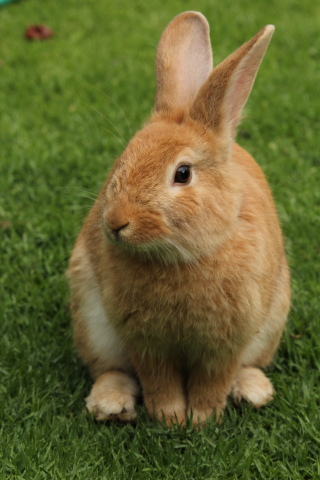I kočkám hrozí přehřátí
O kočkách je známo, že se velmi rády vyhřívají na sluníčku. To ovšem neznamená, že jim nikdy není vedro a netýká se jich riziko přehřátí.
Not only dogs and cats communicate with us non-verbally. Even rabbits tell us what and how they feel with their non-verbal expressions such as postures, gestures and sounds. It helps us understand what mood they are just in. Let’s look at expression which are the most typical ones for these little friends.


Sniffing
As well as other animals, also rabbits rely on their own noses for recognizing well-known people and strangers. However, when the sniffing turns to poking with its nose, your little furry friend wants attention and wants you to caress it and spend time with it.
Stretching
Not many people know that rabbits can stretch the same way cats do. They basically do the same thing with their back. They stand on all four paws and make a subtle noise. Rabbits stretch like this mainly after they wake up or stop relaxing. It looks really cute.
Licking
Rabbits express their affection by this. If they lick you, you know you are one of the people they like and they want to express their gratitude for being good to them. If a rabbit licks you, you may cuddle or caress it. You will show you like it as well by it.
Territory marking
Rabbits mainly use their poop, urine and glands under their chin to mark their territory. These furry friends usually mark their territory by wiping its chin on the things it considers or wants to consider its own. Every rabbit, may it be male or female, has to have a clearly defined territory. It is necessary for them. In the case of urine marking, it is worse as this form of marking comes with an unpleasant smell.
Snuggling up
Even rabbits can sometimes feel endangered. You can see your rabbit is scared of something very easily – it snuggles up. Its aim is to look as small as possible for the potential enemy so it doesn’t even see it. Its pulse is faster and breathing louder which is similar humans.
And what about noises?
If a rabbit is happy and for example, you are cuddling, you can hear it creak with its teeth. That is a noise you might be happy with as it shows the animal is satisfied. However, if it becomes louder and turns into grating, your pet shows you something hurts and it may even seem kind of absent or even apathetic. The third most typical noise is squeaking. Most often, it occurs in young pets and it signalizes fear.
And what is the most typical behaviour of your rabbit?


O kočkách je známo, že se velmi rády vyhřívají na sluníčku. To ovšem neznamená, že jim nikdy není vedro a netýká se jich riziko přehřátí.


To, že se pro kočky a psy prodávají různé konzervy a granule, není jen marketingovým tahem. Obě šelmy mají své specifické výživové potřeby, které se v lecčems rozcházejí, a pokud jim krmivo prohodíte, velmi rychle začnou strádat.


V létě psům nehrozí jen přehřátí. Vysoké teploty mohou i popálit jejich tlapky, pokud je necháme chodit po rozpálených površích.


Vedle FIP a FIV je FeLV další smrtelné virové onemocnění koček. Často je nazýváno kočičí leukémií, protože právě ta je jedním z častých příznaků nemoci. Jak se jí vaše kočka může nakazit, jak to poznáte a jak ji léčit?


Abyssinian, neboli Habešská kočka, je krátkosrstá elegantní dáma se silnou osobností a historií sahající až do starého Egypta. Chce být právoplatným členem rodiny a jejího hustého a hedvábného kožíšku se nebudete moci nabažit.


Pokud hledáte společenské plemeno jako vyšité, už ho máte. Japonský chin totiž bere roli společníka jako své životní poslání. Tenhle minipsík je veselý, hravý a poslušný parťák pro děti i dospělé.


Chcete psovi dopřát to nejlepší, ale na trhu je tolik značek a druhů konzerv, že vám z toho jde hlava kolem? Přináším vám pár tipů, podle čeho vybírat, co by v konzervě chybět nemělo a co by se tam naopak nemělo vůbec ukázat.


Vztahy mezi kočkou a psem bývají všelijaké. Někteří jsou parťáci na život a na smrt, jiní úhlavní nepřátelé. Tady je příběh naší smečky, kterou si prošly všelijaké charaktery, ale vždy jsme se nějak sžili.


V létě ze sebe odhazujeme jeden svršek za druhým. Zvlášť pak v posledních letech, kdy i u nás teploty šplhají až do tropických hodnot. Možná si říkáte, že huňatý kožich vašeho mazlíka mu musí působit peklo a bude lepší ho ostříhat. Je tomu opravdu...


Na kočku venku čeká spoustu dobrodružství a snad i pár kočičích kamarádů, stejně tak tam ale na ni číhá spousta různých nebezpečí. Co všechno může kočku venku potkat?


Nejen psi a kočky s námi neverbálně komunikují. I králíci nám svými neverbálními projevy, jako jsou postoje, gesta a zvuky, dávají najevo, co cítí a jak jim je. To nám pomáhá porozumět, v jakém rozmaru se právě nacházejí. Pojďme se podívat na projevy...


https://krmivo-brit.cz/cs/ I psům dnes můžete pořídit přírodní varianty antiparazitik, nebo jim je vyrobit doma. V čem jsou jejich přednosti a nedostatky?